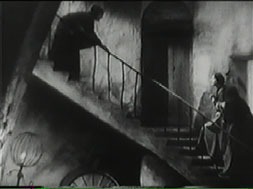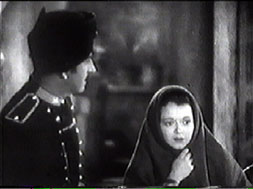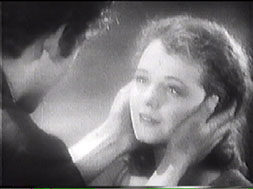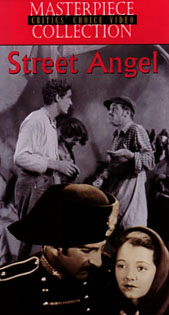

"Street Angel" is a good film - a high quality movie with excellent production values, first rate leads (Janet Gaynor and Charles Farrell), and one of the best directors ever (Frank Borzage). However, it was made as a follow-up to this trio's blockbuster success "Seventh Heaven," and, as with most follow-ups, it doesn't measure up.
Comparisons are often unfair, as is the case here. Assuming there had been no "Seventh Heaven," and standing on its own merits, "Street Angel" does not disappoint. It's not a perfect film, and it has some flaws. Also, as it is with most "delicate" films, critics can pick it apart if they'd like, but by allowing oneself to put aside the need for gritty realism and, instead, yielding to the spirituality and beauty of a love story, "Street Angel" can be a delight.
The initial attraction to the viewer is the
set designs (Harry Oliver) and photography (Ernest Palmer  and Paul Ivano). The streets of
Naples are pictured dark and moody, the stark, bare stucco walls
of the buildings contrasted by sharp shadows and an occasional
iron railing on a set of steps or a balcony. The camera is not
static - it shows us Angela's neighborhood in a broad sweep, panning
almost 270 degrees, picturing the movement and the life of the
poor and the working people of the area, dotted occasionally by
the stiff, uniformed policemen who seem to pop up at the most
opportune (inopportune?) moments. After Angela has been sentenced
by the judge, we see the elongated shadows of those being marched
through the nighttime streets to the prison. Then, out of the
shadows we see Angela running, escaping captivity, desperate to
get back to her mother. These opening sequences are very stark
and very effective.
and Paul Ivano). The streets of
Naples are pictured dark and moody, the stark, bare stucco walls
of the buildings contrasted by sharp shadows and an occasional
iron railing on a set of steps or a balcony. The camera is not
static - it shows us Angela's neighborhood in a broad sweep, panning
almost 270 degrees, picturing the movement and the life of the
poor and the working people of the area, dotted occasionally by
the stiff, uniformed policemen who seem to pop up at the most
opportune (inopportune?) moments. After Angela has been sentenced
by the judge, we see the elongated shadows of those being marched
through the nighttime streets to the prison. Then, out of the
shadows we see Angela running, escaping captivity, desperate to
get back to her mother. These opening sequences are very stark
and very effective.
One 1928 reviewer labeled the performances of Gaynor and Farrell as "grand," but gave the edge to Farrell. Actually, Gaynor far out-acts Farrell. She is perfectly suited for the poor waif, and gives both a spirited and tragic performance. Farrell, on the other hand, spends much time staring dumbly at Gaynor. Whether his fault or Borzage's, his Gino comes across as somewhat of a simpleton. The same reviewer says Gaynor was never meant to be a "peppery Italian," and that may be so. Neither she nor Farrell are real convincing in that aspect of their roles, but, that is a minor concern, for it's a love story that's not limited to any one nationality.
Where the reviewer misses the mark entirely
is in calling the story "silly." As mentioned before,
it's a delicate story and not meant for all tastes, but it's not
silly. For example, possibly the most moving part of the story
shows Angela and Gino, after much misfortune, celebrating the
prospect of Gino's new, well-paying job and their marriage which
is scheduled for the next day. Just as they are about to spend an idyllic evening together,
the policeman comes to arrest her. Trying to keep her past from
Gino, she begs the policeman to allow her one last hour with Gino
before being taken away. He does, and she tearfully shares one
last meal with him, all the while keeping Gino ignorant of the
policeman waiting outside.
spend an idyllic evening together,
the policeman comes to arrest her. Trying to keep her past from
Gino, she begs the policeman to allow her one last hour with Gino
before being taken away. He does, and she tearfully shares one
last meal with him, all the while keeping Gino ignorant of the
policeman waiting outside.
When she finally convinces him to retire for the night, she goes outside and starts to leave with the policeman. However, as has been their ritual, Gino will whistle "Angela Mia" before going to bed and await her whistle in return from the balcony of her upstairs room. Outside with the policeman she hears the whistling, and, through her tears and sadness, she is barely able to return the whistle so Gino can go to bed happily. Silly? For one caught up in the movie, it's a tender moment. For the callous, yes, it may be silly.
The weakest part of the story is possibly the
ending. When Angela assures Gino that she is still like the Madonna
he painted, he looks into her eyes and, instead of wanting to
kill her as he did moments  before,
he takes her in his arms and begs for forgiveness. It would seem
some explanation about how she was arrested mistakenly for soliciting
and how she was only stealing to get medicine for her sick mother
would be in order, but, that explanation was not forthcoming.
Certainly, Borzage's ending is more "spiritual" and
in keeping with the old adage that "love conquers all,"
but it leaves the viewer somewhat less than satisfied.
before,
he takes her in his arms and begs for forgiveness. It would seem
some explanation about how she was arrested mistakenly for soliciting
and how she was only stealing to get medicine for her sick mother
would be in order, but, that explanation was not forthcoming.
Certainly, Borzage's ending is more "spiritual" and
in keeping with the old adage that "love conquers all,"
but it leaves the viewer somewhat less than satisfied.
 The print
reviewed is from the Killiam Collection and was distributed by
Critic's Choice, but is unfortunately out of print. It has a very
enjoyable vintage orchestra score that accompanied the movie at
its time of release. Gino's whistling is included in the score
as \well as singing in a couple of instances, all adding to the
enjoyment of the movie. The biggest drawback to this print is
that it is dark. The scenes in the city at night are meant to
be dark and moody anyway, so it's hard to tell how much is meant
to be and how much is due to the print quality, but, in a few
instances, the characters are barely visible. The worst is in
the first 30 minutes of the movie, and then is improves after
that.
The print
reviewed is from the Killiam Collection and was distributed by
Critic's Choice, but is unfortunately out of print. It has a very
enjoyable vintage orchestra score that accompanied the movie at
its time of release. Gino's whistling is included in the score
as \well as singing in a couple of instances, all adding to the
enjoyment of the movie. The biggest drawback to this print is
that it is dark. The scenes in the city at night are meant to
be dark and moody anyway, so it's hard to tell how much is meant
to be and how much is due to the print quality, but, in a few
instances, the characters are barely visible. The worst is in
the first 30 minutes of the movie, and then is improves after
that.